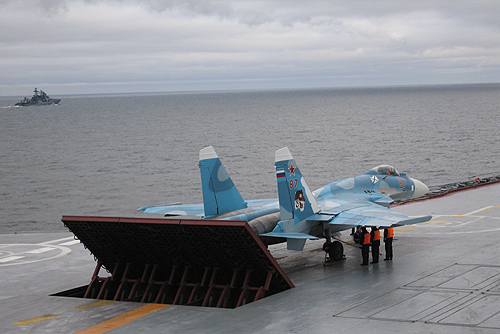sankum wrote:As per IN RFI for INS Viramaditya(inferred) it is 13 degree skijump with restraining gear launch distance @125m, 190m and 195m while for INS Vikrant it is 14 degree skijump with launch distance at 144m, 203m and 213m.
As per AI2017 reports in this forum NLCAmk1 is 800Kg heavier than LCAmk1 so can be taken at 7.3T empty weight and clean weight at 10.6 T with full internal fuel of 2.5T and 2 CCM. If max MTOW from carrier is 13T then we have 2.4Tpayload and if it is 13.5T like LCA mk1 then the payload is 2.9T from carrier.
Excellent. Now , I plugged in the numbers for that into my spread sheet. I derated the LCA's thrust by 5% instead of the 10% earlier (which I think was excessive).
But let us look at the bare minimum ,
I think the N-LCA must carry .
Air to Air -> 2* 1000 kg drop tanks, 2* CCM, 2* AAM, SPJ pod. --> Approx 2000 + 300 + 500 + 150 = approx 3T in Air defence
Strike -> 2* 1000 kg drop tanks, 2* CMM, 1*LDP, 1*SPJ ,2*AAM --> Approx 3T + 750KG class anti ship (Harpoon/Exocet) or 2*500Kg bombs --> Apporx 3.75t to 4 ton in strike
Let us look at
VikAd first.
For 195m t.o run , the MTOW is 13 tons (with the 100KCAS as the ramp exit speed and the ship putting out 25kts ~ 23.5kCAS). The payload will be 2.84tons ..
Not good enough in even A2A role.
Now for
Vikrant
For 203 m t.o run , the MTOW is 13.6 tons (with the 100KCAS as the ramp exit speed and the ship putting out 25kts ~ 23.5kCAS). The payload will be 3.77tons ..
Good enough in A2A role only.
For 213 m t.o run , the MTOW is 14.4 tons (with the 100KCAS as the ramp exit speed and the ship putting out 25kts ~ 23.5kCAS). The payload will be 3.77tons ..
Good in A2A role AND strike, both anti shipping and land.
Now let us look at Mig29K with the VikAd
With the MTOW of the Mig29K and the installed thrust (derated by 5%) from Wiki, plugging in the values for the 190m take off run (with carrier 23.5 kCAS), we find the ramp exit speed is 104 KCAS! This is exactly similar to the numbers we saw for the LCA in the presentation.
However, the Mig29 in this case is carrying 5.5 tons of fuel and 6 tons of payload. A pretty potent package.
It is obvious from the numbers that the N-LCA (as is, with 100kCAS ramp exit) is of little utility in the VikAd. For the Vikrant, it is fully useable in the A2A and strike role. However the Mig29K offers far greater capability (as it obviously will, it is a bigger plane and can carry bigger payload to a longer distance) and has the installed thrust to take off even from the VikAd.
So the Navy's decision on the N-LCA Mk1
makes a lot of sense.
What lets the NLCA MK-1 as-is, down is the following. The full 90KN thrust is NOT available on the deck. If the 90KN was available, then the MTOW on the VikAd is 13.7Tons and the payload is 4Tons and it would have been FULLY useable in both A2A and Strike.
In addition, the VikAd itself is a piece of garbage. It is 20 m longer than the Vikrant, but has a t.o run that is actually 20 m
shorter. It is an EXCUSE of an aircraft carrier. It was not designed as one, and the conversion to a VikAd from Adm. Gorshkov has kept the bulk of it's short comings in place. It is something that should NEVER have been acquired. We would have been indeed better off in acquiring the Varyag hull like the Chinese did and refurbishing it, by the Russians if need be .
The one-two punch of shortfall in installed thrust and the sub optimal rubbish of VikAd lets the NLCA MK-1 down in it's present form.
However,
IF they manage to bring the ramp exit speed to 95 KCAS from the current 100 odd KCAS , a difference of just 5 to 7 kCAS, the NLCA Mk1 becomes fully useable in both A2A and strike, on the VikAd with MTOW of 14 tons.
Oh, btw, the 125m t.o run for the VikAd and the 144m run on the Vikrant is a JOKE . Plugging in the numbers for the Mig29K ,for the 125m T.O, the MTOW is 15.4 Tons. Now the loaded wt of the Mig 29K is 18.5 tons. That means that the Mig 29K on the 125m run is taking off from with 3 TONS less than usual 5.5 tons and is carrying just 2.5tons of fuel and no allowance for ANY weapons.
And looking at it more broadly, the joke becomes even more obvious. The CATs on the US carriers are roughly 300 ft long which is approx 100m. Now in 100m, a CAT , throws out a F18 (E/F) @ approx 165kts . Now , a similar sized and loaded plane with similar powering to reach 100 knots its on it's own power is impossible. (the 144m run, will see a MTOW of 18tons, which means the fully fuelled up Mig 29 can't take off!).
The best hope is if the aero and controls guys do some magic and can get the launch exit speed close to 90 KCAS or thereabouts, the LCA MK1 will be in full play in the VikAd and the Vikrant. The LCA Mk2 will of course bring far greater capability to the table and is probably well worth it.

